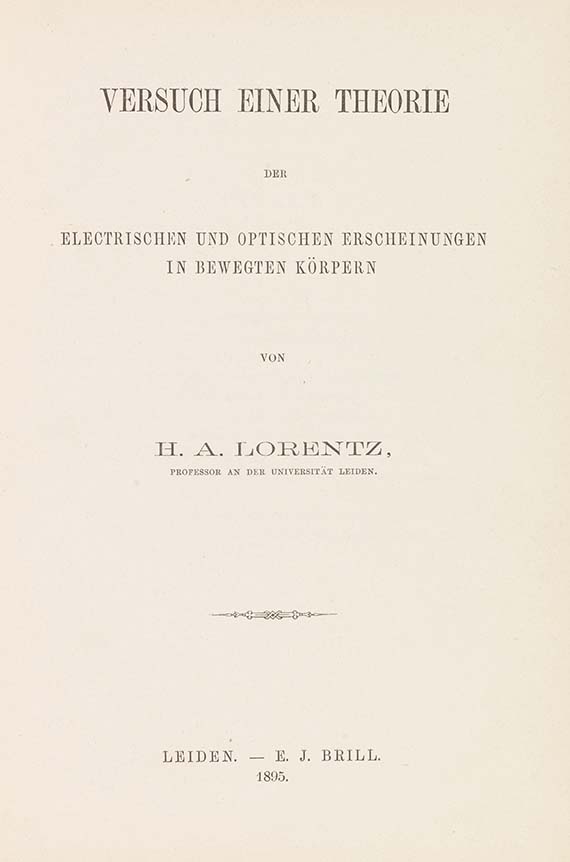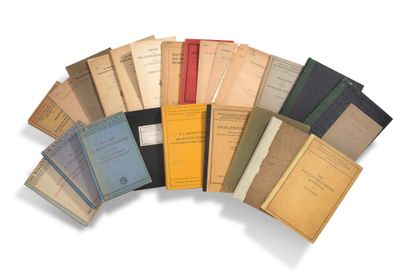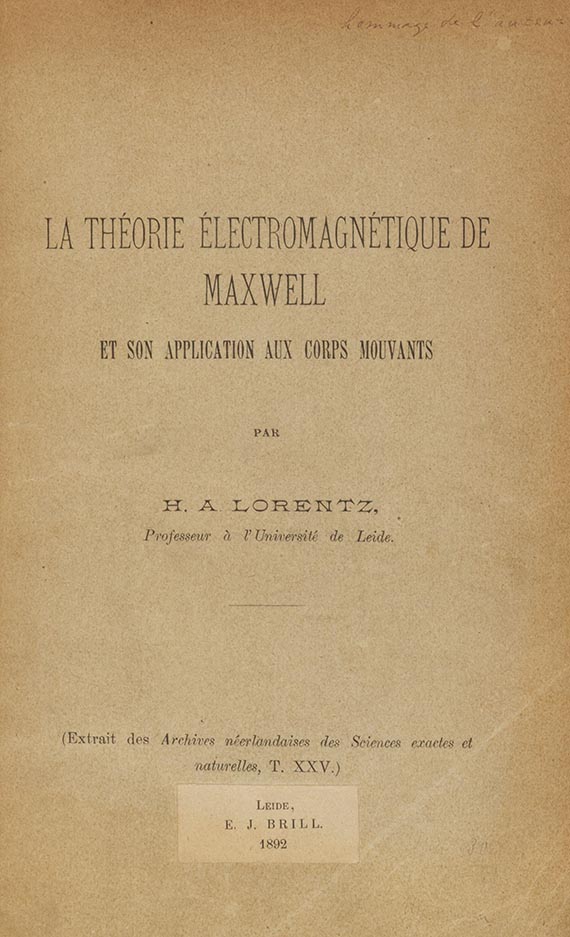LORENTZ, Hendrik Antoon (1853-1928). Versuch einer Theorie der electrischen und optischen Erscheinungen in bewegten Körpern. Leiden: E.J. Brill, 1895.
LORENTZ, Hendrik Antoon (1853-1928). Versuch einer Theorie der electrischen und optischen Erscheinungen in bewegten Körpern. Leiden: E.J. Brill, 1895. 8 o (225 x 146 mm). Contemporary half cloth, original front wrapper laid down (some rubbing and staining); quarter morocco slipcase. FIRST EDITION of the second of Lorentz's two expositions of his electron theory of matter (the first article appeared in 1892), THE MATHEMATICAL FOUNDATION FOR EINSTEIN'S SPECIAL THEORY OF RELATIVITY. "Hertz's experimental and theoretical researches generated widespread interest in Maxwell's theory among Continental physicists. Of the major theoretical statements of Maxwellian electrodynamics following Hertz's researches, several advanced a molecular view of electricity together with a stationary ether. Such theories - soon to be called electron theories - were proposed independently in the early 1890s by Lorentz, by Weichert, and by Larmoor... Of the three theories, Lorentz's gained the greatest authority on the Continent, in part because of its clear, if ultimately unsatisfactory, dualism of electron and field" ( DSB ). Lorentz's theory, for which he won the Nobel prize for physics in 1902 (shared with Pieter Zeeman), rested on the "fundamentally new assumption that the behavior of light and matter could be understood in terms of particles" (Norman). His articles contain the mathematical explanation of the results of the Michelson-Morley experiment, one of several "ether-drift" experiments that had disproved the theory that the speed of light is interfered with by the "luminiferous ether" that was still believed to surround the earth. The ether theory had attempted to explain the so-called "angle of aberration", the fact that in examining any fixed star it is necessary to point the telescope a bit in advance of the star. In this second paper Lorentz explained the optical aberration by his "famous contraction hypothesis" ( DSB ) which assumes that matter is of an electrical nature, so that "all electrical particles became shortened when in motion along the direction in which the ether drifts" ( PMM ). In 1905 Einstein published his special theory of relativity, which refuted the Michaelson-Morley experiment as fundamentally flawed since it presumed the existence of an observer independent of and unrelated to the universe, and for which he adopted the equations of Lorentz's theory. Although Lorentz admired Einstein's reinterpretations of his equations, "to the end of his life he believed that the ether was a reality and that absolute space and time were meaningful concepts" ( DSB ). Norman 1388; PMM 378(b).
LORENTZ, Hendrik Antoon (1853-1928). Versuch einer Theorie der electrischen und optischen Erscheinungen in bewegten Körpern. Leiden: E.J. Brill, 1895.
LORENTZ, Hendrik Antoon (1853-1928). Versuch einer Theorie der electrischen und optischen Erscheinungen in bewegten Körpern. Leiden: E.J. Brill, 1895. 8 o (225 x 146 mm). Contemporary half cloth, original front wrapper laid down (some rubbing and staining); quarter morocco slipcase. FIRST EDITION of the second of Lorentz's two expositions of his electron theory of matter (the first article appeared in 1892), THE MATHEMATICAL FOUNDATION FOR EINSTEIN'S SPECIAL THEORY OF RELATIVITY. "Hertz's experimental and theoretical researches generated widespread interest in Maxwell's theory among Continental physicists. Of the major theoretical statements of Maxwellian electrodynamics following Hertz's researches, several advanced a molecular view of electricity together with a stationary ether. Such theories - soon to be called electron theories - were proposed independently in the early 1890s by Lorentz, by Weichert, and by Larmoor... Of the three theories, Lorentz's gained the greatest authority on the Continent, in part because of its clear, if ultimately unsatisfactory, dualism of electron and field" ( DSB ). Lorentz's theory, for which he won the Nobel prize for physics in 1902 (shared with Pieter Zeeman), rested on the "fundamentally new assumption that the behavior of light and matter could be understood in terms of particles" (Norman). His articles contain the mathematical explanation of the results of the Michelson-Morley experiment, one of several "ether-drift" experiments that had disproved the theory that the speed of light is interfered with by the "luminiferous ether" that was still believed to surround the earth. The ether theory had attempted to explain the so-called "angle of aberration", the fact that in examining any fixed star it is necessary to point the telescope a bit in advance of the star. In this second paper Lorentz explained the optical aberration by his "famous contraction hypothesis" ( DSB ) which assumes that matter is of an electrical nature, so that "all electrical particles became shortened when in motion along the direction in which the ether drifts" ( PMM ). In 1905 Einstein published his special theory of relativity, which refuted the Michaelson-Morley experiment as fundamentally flawed since it presumed the existence of an observer independent of and unrelated to the universe, and for which he adopted the equations of Lorentz's theory. Although Lorentz admired Einstein's reinterpretations of his equations, "to the end of his life he believed that the ether was a reality and that absolute space and time were meaningful concepts" ( DSB ). Norman 1388; PMM 378(b).


.jpg)

.jpg)






Try LotSearch and its premium features for 7 days - without any costs!
Be notified automatically about new items in upcoming auctions.
Create an alert